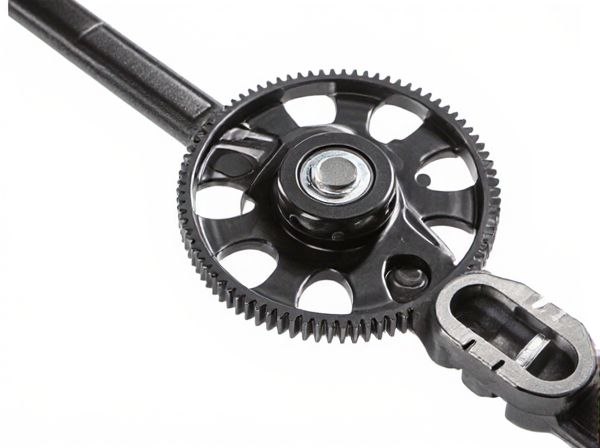
Photo illustration: Helical Gear Steering vs Straight Gear Steering
Helical gear steering offers smoother and quieter operation compared to straight gear steering due to the angled teeth that engage gradually, reducing noise and vibration. Straight gear steering provides a more direct and simpler design, which can be easier to manufacture and maintain but often results in increased noise and less smooth movement. Your choice depends on whether you prioritize quiet, smooth performance or straightforward, cost-effective mechanics.
Table of Comparison
| Feature | Helical Gear Steering | Straight Gear Steering |
|---|---|---|
| Gear Design | Angled teeth for smoother engagement | Straight teeth for direct engagement |
| Noise Level | Low noise, quieter operation | High noise, louder operation |
| Efficiency | Higher efficiency due to continuous contact | Lower efficiency due to intermittent contact |
| Durability | Better wear resistance, longer lifespan | Prone to quicker wear and tear |
| Load Capacity | Handles higher loads effectively | Limited load capacity |
| Manufacturing Cost | Higher cost due to complex design | Lower cost, simpler manufacturing |
| Application | Preferred in modern vehicles for smooth steering | Used in older or basic steering systems |
Introduction to Steering Mechanisms
Helical gear steering offers smoother and quieter operation due to its angled teeth design, which provides gradual engagement compared to straight gear steering with its direct and simpler tooth alignment. The helical gears reduce noise and vibration, improving precision and durability in steering systems. Straight gear steering mechanisms, though less complex and easier to manufacture, typically generate more noise and wear, making them less suitable for high-performance or comfort-focused applications.
What is Helical Gear Steering?
Helical gear steering utilizes angled teeth on the gear wheels, allowing for smoother and quieter operation compared to straight gear steering, which has teeth aligned parallel to the gear axis. The angled teeth in helical gears engage gradually, reducing noise and vibration while providing improved load capacity and durability. This type of steering system is commonly used in automotive and industrial applications where enhanced precision and noise reduction are critical.
What is Straight Gear Steering?
Straight gear steering uses gears with teeth aligned parallel to the gear's axis, resulting in straightforward manufacturing and cost efficiency. This design produces moderate noise levels and transmits torque directly but tends to wear faster due to increased friction between gear teeth. Commonly applied in vehicles requiring simple, reliable steering mechanisms, straight gear steering offers precise control but lacks the smoothness of helical gear systems.
Design and Construction Differences
Helical gear steering systems feature angled teeth that engage gradually, resulting in smoother operation and quieter performance, whereas straight gear steering systems use teeth cut straight across, causing more noise and vibration due to abrupt engagement. The construction of helical gears involves complex manufacturing processes to create the angled teeth, enhancing load distribution and durability, while straight gears have simpler designs with direct tooth contact, making them easier and cheaper to produce. Design-wise, helical gears offer better efficiency in high-speed and heavy-load applications, whereas straight gears are typically found in lower-speed, lighter-duty steering mechanisms.
Efficiency and Performance Comparison
Helical gear steering systems offer higher efficiency and smoother performance due to their angled teeth, which engage gradually and distribute load evenly, reducing noise and vibration compared to straight gear steering. Straight gear steering, with its straight-cut teeth, provides simple and robust design but tends to generate more noise and less efficient power transfer, impacting overall steering responsiveness. In terms of performance, helical gears deliver improved durability and quieter operation, making them preferable in applications demanding precision and comfort.
Noise and Vibration Levels
Helical gear steering systems generate lower noise and vibration levels compared to straight gear steering due to their angled teeth, which engage gradually and provide smoother operation. Straight gear steering features parallel teeth that mesh abruptly, causing higher noise and increased vibration during steering maneuvers. Reduced noise and vibration in helical gear steering enhance driver comfort and vehicle handling precision.
Durability and Maintenance
Helical gear steering systems offer superior durability compared to straight gear steering due to their angled teeth that distribute load more evenly, reducing wear and extending component lifespan. Maintenance requirements for helical gear systems are generally lower, as smoother operation decreases stress on parts and lowers the frequency of adjustments or replacements. In contrast, straight gear steering experiences higher noise levels and faster wear from direct tooth contact, leading to more frequent maintenance and shorter durability.
Cost Considerations
Helical gear steering systems generally incur higher initial costs due to complex manufacturing processes and precision engineering compared to straight gear steering, which are simpler and cheaper to produce. Maintenance expenses for helical gear steering tend to be lower because of smoother operation and reduced wear, whereas straight gear steering may require more frequent servicing. Long-term cost efficiency of helical gear steering often offsets its upfront investment, making it suitable for applications demanding durability and noise reduction.
Applications in Modern Vehicles
Helical gear steering systems offer smoother, quieter operation, making them ideal for luxury and high-performance vehicles that prioritize noise reduction and precise handling. Straight gear steering, characterized by simpler design and direct engagement, is commonly used in older or economy vehicles where cost-efficiency and reliability under basic driving conditions are essential. Modern automotive manufacturers increasingly prefer helical gear steering for electric and hybrid models to enhance driving comfort and reduce mechanical wear.
Which Steering System is Best?
Helical gear steering offers smoother and quieter operation due to angled teeth that provide gradual engagement, reducing noise and wear compared to straight gear steering, which features straight-cut teeth with more noise and vibration. Helical gears typically deliver better durability and efficiency in high-speed and heavy-duty applications, while straight gear systems are simpler and more cost-effective for low-speed, lighter use. Overall, helical gear steering is best for performance and longevity, whereas straight gear steering suits budget-conscious or less demanding steering needs.
 caratoz.com
caratoz.com